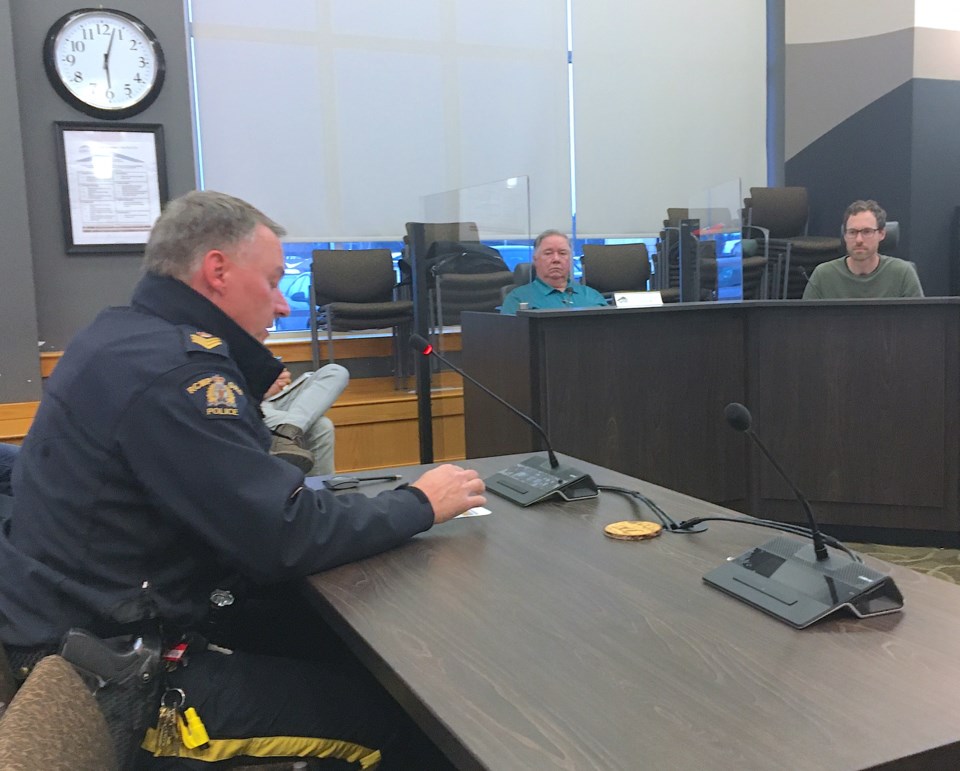SUNDRE — Property crimes, especially on more remote oil and gas lease sites, trended upward over the past year, council recently heard.
Sgt. Trent Sperlie, the Sundre RCMP detachment’s newest commander, presented in-person a quarterly crime statistics report to council during a recent meeting.
“There’s nothing remarkable about the stats, other than property crime is up a significant amount,” said Sperlie.
From October 2020 to December 2021, his department recorded a 34 per cent increase. According to data outlined in Sperlie’s report to council, total property crimes in that time period amounted to 94.
Incidents included a range of offences from break and enter to theft of motor vehicle as well as possession of stolen goods and mischief damage to property.
While that was up from the 70 instances reported in 2020, it was down substantially from a peak of 130 cases in 2019. In 2018, 96 instances were recorded while 120 were reported in 2017, the last year included in the report. Overall, despite the increase over the past year, property crime was down about 22 per cent when comparing stats between 2017 and 2021.
“Property crime is something that is in our priorities — it’s probably our number 1 priority,” Sperlie told council. “Everything else is on the decline.”
Coun. Chris Vardas asked the sergeant what the plan to address the issue is.
“How are you guys approaching this?” said Vardas.
“We have different ways of approaching that,” said Sperlie.
Some of the property crime being experienced, the sergeant said, is occurring on the rural oil and gas lease sites.
“We know what times those are happening at,” he said. “So, we focus patrols in those areas at those times. In one case here recently, a member doing exactly that actually caught two people in the act of stealing from those well sites.”
Another factor in the property crime-fighting strategy involves working closely with intelligence law enforcement counterparts in Calgary, he said.
“We’re trying to target prolific offenders. We’ve got a few in the area right now, and what the members are doing is they’re contacting those prolific offenders on a regular basis and putting the pressure on them,” he said, adding one known offender had recently been sent back into remand.
“That’s another way that we can combat this, is these prolific offenders — if they offend again — send them back to remand,” he said. “If they’re in remand, they can’t be committing any crime.”
When it comes to investigational techniques employed by authorities, the sergeant said he was not able to openly discuss those tactics in detail.
“But there are methods of detecting and tracking a crime as it’s happening,” he said. “We’re utilizing those avenues as well.”
There are also preventative strategies including public awareness campaigns encouraging people to play a part in reducing the potential for property crime by taking simple steps such as locking vehicles and never leaving valuables inside, he said.
Many thieves target random crimes of opportunity, and will quickly move on from a locked vehicle in search of easier prey with doors that were left open, he said.
“We try to prevent crime by taking away the opportunity to commit the crime,” said Sperlie.
“Crimes where vehicles are left open or valuables are left in them, those are easy targets. We can prevent those crimes, and I know for a fact we’ve prevented them because we’ve had two or three incidents within the last week where video surveillance has shown a potential thief pull up to vehicles and checked the door handles, but moved on because they were locked.”
Coun. Paul Isaac said he never used to lock up his trucks at home until recently when he stepped out one morning to go to work and found the front doors on both his personal and work vehicles had been left open. Although no valuables were taken, Isaac said neither vehicle would start as the batteries had drained as a result of the doors being left open and the interior lights on.
The sergeant said that’s where efforts to encourage preventative measures through public engagement can help reduce instances of property crime.
“The crime is bad, but we don’t want (people) to think they live in an anarchist world, because they don’t,” he said, adding social media sometimes has a tendency to exaggerate or sensationalize an issue.
Other stats included on the report showed total persons crimes — such as robbery or assault — remained relatively steady over the past years. The peak was in 2018, with 53 recorded incidents, while the lowest number was recorded in 2017 with 35 reports. There were 43 in 2020 and 44 in 2021.
Coun. Owen Petersen asked about a portion of the sergeant’s report that mentioned the RCMP’s pilot program to trial body-worn cameras, and asked if there is a timeline in place for a national roll-out.
“I don’t know the exact timeline,” said Sperlie. “I know that as soon as they finish the pilot project and they’ve identified the particular equipment that they want to use, I think they’re going to roll it out fairly quickly. It’s something that we on the frontline have asked for for probably 10 years at least now. Recent events have pushed it right to the edge where the RCMP is now saying, ‘Yes, we want this.’”
Council carried a motion to accept the sergeant’s report for information.



